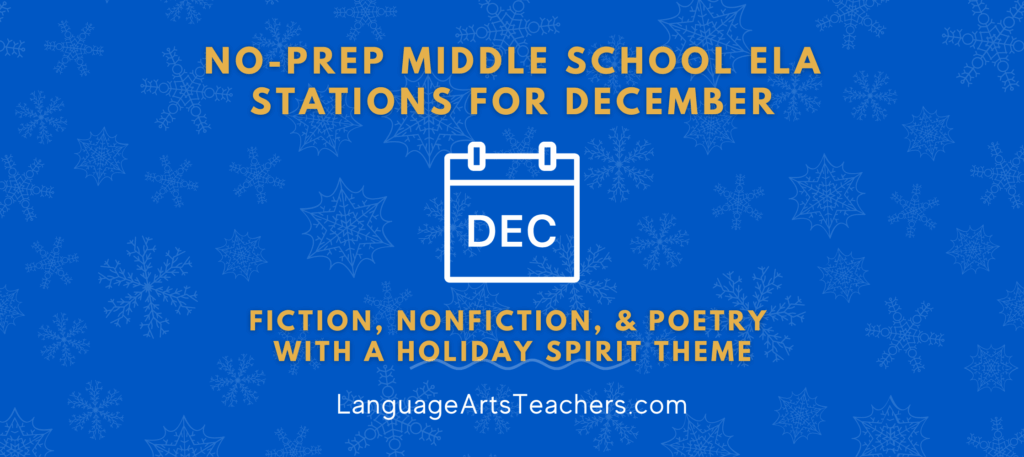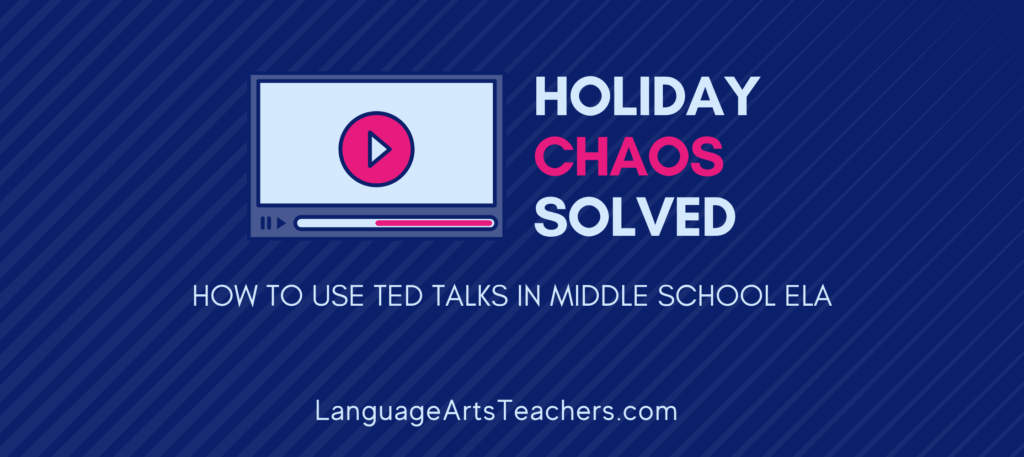 NO PREP NEEDED!
NO PREP NEEDED!
REVIEW ANY 6TH GRADE
LANGUAGE ARTS UNIT
USING YOUR SCHOOL LIBRARY!
1) GENRE REVIEW
This is a no-brainer since you’re in the library, but it’s how you implement the review to make in interactive and memorable. Here’s what to do for this “scavenger hunt” of sorts:
-
While still in the classroom, have students help you make a list of the genres and sub-genres they have learned about (write them on the board). You may come up with something like this:
Fiction (realistic, historical, sci-fi, fantasy)
Non-Fiction (memoirs, biographies, autobiographies, informational)
Drama
Poetry
-
Once you’re in the library, split students into groups (it could be as few as two per group depending on the size of the class).
-
Each group locates a few books from the genre they were assigned (time them so they’ll locate what they need within 5 minutes).
-
Each group reads a portion of the text and chooses 4 – 5 qualities of their genre that they observe in the text. (time them: 15 minutes!)
— For instance, one group might find a fantasy novel and as they read the summary on the back and inside flap, they see that elves and monsters are mentioned along with a journey to retrieve a magical ring of power. They might look at the first chapter, read two pages, and observe that there is also a mountain trail that leads to the sky-lands. Right there, they have found several qualities of a fantasy text.
-
Give them 20 minutes to create a poster (even just a sheet of plain copy paper can be a poster) showcasing the following:
— Type of genre and sub-genre
— Titles of two books / texts found in the sub-genre
— A list of specific qualities that represent the sub-genre
— Sketch an image or images that also represent the sub-genre
Display the posters in the hallway outside your class or in the class, wherever there is space.
Follow Up Later— Allow students to browse all the genre posters and select a text to read of their own choosing. In fact, when you remind kids that they have to check out new books, you can even point them to the genre posters as a way to help them decide beforehand what kind of book they’ll want to get. That definitely helps with the issue of kids wandering aimlessly in the library complaining that “there’s nothing here” to check out.
2) FIGURATIVE LANGUAGE REVIEW
Conduct this review activity in much the same way as you would the GENRE REVIEW you just read about.
* While still in the classroom, have students help you make a list of the types of figurative language they have learned about (write them on the board). You may come up with something like this:
simile, metaphor, onomatopoeia,
alliteration, hyperbole, personification, etc.
-
Once you’re in the library, split students into groups (3-5 per group depending on the size of the class). Challenge the groups to a friendly competition: Which group can find one example of each type of figurative language in the shortest amount of time!!
-
Each student should have a piece of notebook paper so he or she can jot down the example straight from the text as they are located.
-
It’s typically easier to locate figurative language in poetry, but novels are good sources, too— especially novels and stories that use a lot of humor! Each group locates a few poems or other sources that they can browse through to look for figurative language.
-
Once you are in the library and the students have received these instructions, say “GO!” and then set a timer!
-
The students will have to work together collaboratively to divide and conquer, locating books and poems to use to search for the figurative language.
-
A group wins only when they have found one example of each type of figurative language, copied it legibly on paper, and the title of the book and page number it came from (they’ll need this later for the follow-up activity).
-
Follow Up Later:
Remix the groups! Divide students into groups based on one type of figurative language. Say, “You four are the SIMILE group” and “You five are the HYPERBOLE” group.
In those groups, students will create a poster (plain printer paper is fine) that showcases the best examples of the types of figurative language they found. Each poster should contain the following:
— The name of the figurative language
— 3 – 5 examples written neatly (the quotes they copied earlier from the books or poems in the library— make sure they kept their papers from the contest!)
— The sources of the figurative language (titles and page numbers)
— images sketched / drawn to help convey the meaning
-
Post these in your classroom, the hallway, or even laminate and place in a class notebook to use as a resource for when kids say, “I forgot what a metaphor is.” It’s great to be able to keep doing what you’re doing and simply say, “Check the figurative language notebook.”
-
If you go the notebook route, you can even save that notebook as a resource for next year’s kiddos to use throughout the year. Just a thought!
3) TEXT STRUCTURE / TEXT FEATURES REVIEW
This is a fun way to use some of the research resources in your school’s library, though it can also be done with computers:
* While still in the classroom, have students help you make a list of the types of text structures they have learned about (write them on the board). You may come up with something like this:
description, problem / solution, cause / effect,
sequence, chronological, compare / contrast
If you’re in the library and you’ll be using print resources, allow students to use what your library has to offer in terms of research resources. Are there student-friendly magazines available? Reference books? Non-fiction / expository books about animals, people, places?
If you’re using computers, allow students to use sites like TweenTribune to locate articles and find examples for each type of text structure.
Again, students will record results on their own notebook paper (no-prep for you!). Students will make a “t-chart” so that text structures are listed with examples on one side and the text features used in each article are listed on the other side. For example:
Remember, this activity is for a review. It assumes that these are not new concepts, but concepts to be practiced. I allow students to work together, to talk about what they are reading and learning, and I let them help each other and use any notes or foldables they have from prior lessons to assist. It’s not a test— it’s a review.
You can decide whether or not you want students to find one example of each or if there’s a better way. Personally, I have found that telling them to find one example of each takes a really, really long time with this activity. I typically let them choose any 3 of the 5, for example, and then I call it a day.
Follow Up:
Once the assignment is complete—and this assumes you have a whole class day in the library or with the computers—I like to let the students turn in their papers and then enjoy the remaining few minutes of class to simply read. Without meaning to, we tend to teach them that reading for pleasure involves fiction. Why not nonfiction, too? Let your students have some free reading time to explore more resources and topics that interest them in the non-fiction expository genre.




